SeeLevel RV Tank Monitoring System
Tank Monitoring Systems That Work
Article Date: September, 2011
Article and Photography by Mark Quasius
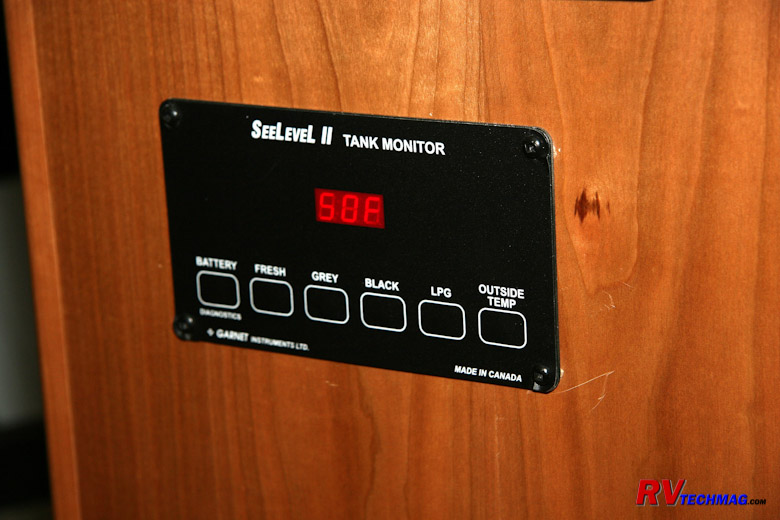
An RV is somewhat self-sufficient. Your RV has an on-board fresh water supply, as well as holding tanks to
capture the gray water from the sinks and black water from the toilet. It's important for the RV owner to know how much fresh water
is left and how much room is left in the holding tanks. To monitor these levels, RV manufacturers include tank-monitoring systems.
These systems generally consist of probes placed at 1/3-tank-level intervals. When the fluid in the tank reaches a given probe, it
creates a circuit between it and the bottom tank probe and lights up a bulb or LED on the display panel.
|
The biggest problem with this system is that it is notoriously inaccurate. The sensors are inserted into
the tank and in contact with the fluid in the tank. This makes them subject to fouling and corrosion. Readings will be very erratic
and the system is basically useless until the sensors can be cleaned. The second problem with this is that the system is only designed
to give approximate readings.
|
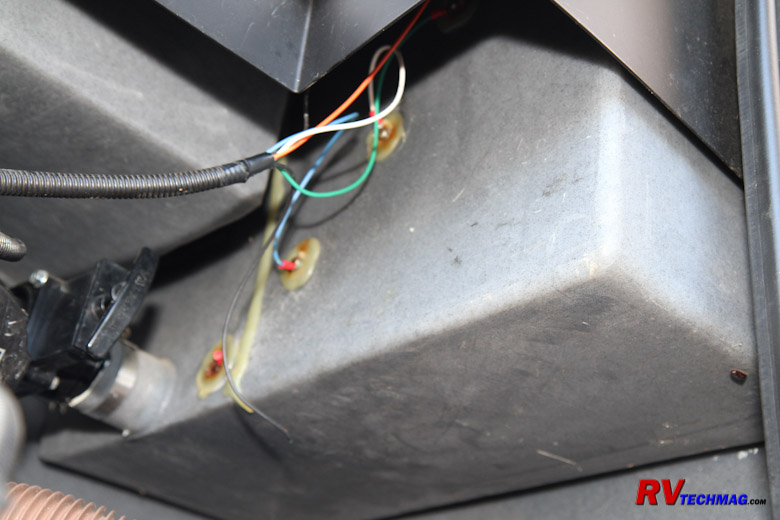
Internal tank sensors are subject to corrosion and rarely give accurate readings.
|
The biggest problem with this system is that it is notoriously inaccurate. The sensors are inserted into the
tank and in contact with the fluid in the tank. This makes them subject to fouling and corrosion. Readings will be very erratic and
the system is basically useless until the sensors can be cleaned. The second problem with this is that the system is only designed
to give approximate readings.
For example, let's say you want to take a shower. Your shower typically fills up only a third of the gray tank.
When you check the display, you find the 1/3-tank-level LED illuminated, meaning 2/3 of the tank is empty. But by the time you finish
your shower you notice that the gray tank is backing up into the shower stall because the gray tank is now full. The same holds true
for the fresh-water tank. It may indicate 1/3 full, but it may actually be near the 2/3 mark.
Fortunately, there is a solution. Garnet Technologies makes the SeeLevel tank monitoring system that overcomes
all of these limitations. Garnet is well known for providing tank-monitoring systems for the petroleum industry, and that technology is
present in their SeeLevel gauges designed for RV tank monitoring. The beauty of these sensors is that they are attached externally to
the tanks so they never contact the liquids within. This means they are not subject to fouling or corrosion and are basically maintenance
free. The sensors are not limited to 1/3 increments either. Each sensor strip has a number of segments that can report tank levels in
2-percent increments. With this system, a tank that is just below 2/3 level will display something like 62 percent on the SeeLevel
digital display. You'll now have accurate information that you can trust.
|
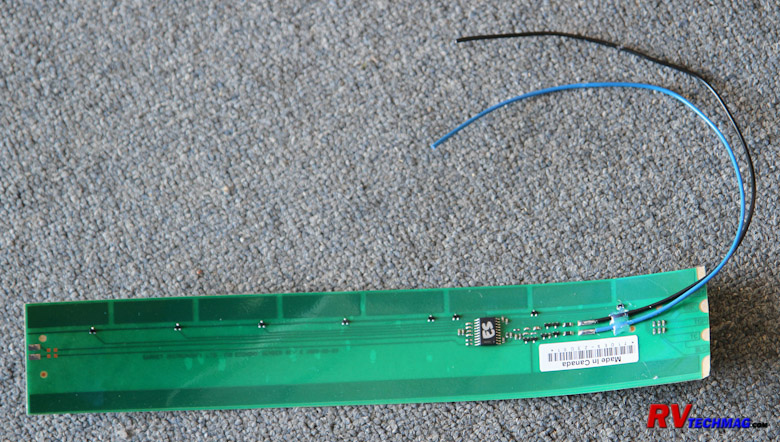
SeeLevel sensor strips have electronics imbedded into the printed circuitry that send signals through the tank's contents
without having direct contact with the tank's contents. The strip can be trimmed to length to accommodate shorter tank heights.
|
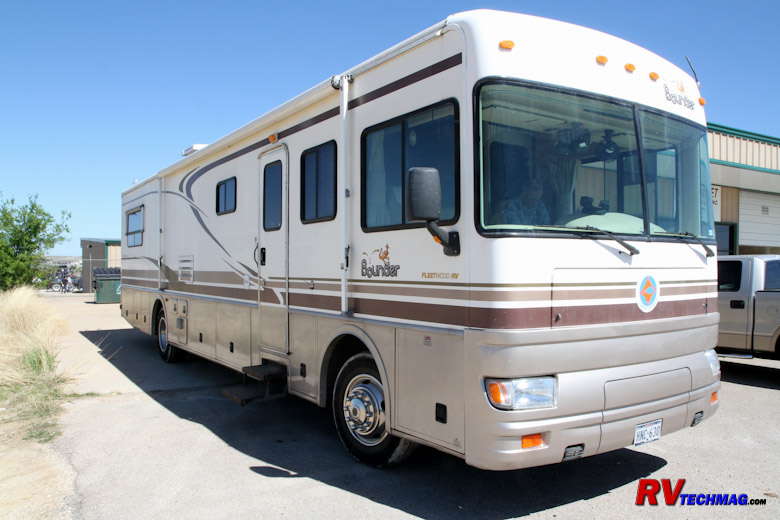
We installed a SeeLevel system in this 2001 Bounder.
|
SeeLevel gauges are now being installed by many RV manufacturers into their high-end RVs. But the system is
an easy retrofit installation into an RV equipped with internal tank sensors. A large number of RV dealers are retrofitting this
system to customers' RVs, but it's a fairly simple install and can be an easy do-it-yourself project for many RV owners. To illustrate
this I visited Garnet Technologies in Granbury, Texas, and installed a SeeLevel monitoring system into a 2001 Bounder motorhome.
The Installation
|
The Bounder came equipped with a very large display that was located in the center of the dash. It was unique
in that it used internal tank sensors at 1/4 increments rather than 1/3. However, it was never very accurate, so a SeeLevel 709 system
was slated to replace it. The 709 display provided readings for battery voltage, fresh water tank level, gray tank level, black tank
level, and propane tank level. The SeeLevel sensors are nice and compact while the original Bounder display was quite large so an
adaptor plate was made to help fill the large hole left when the original display was removed from the dash.
|
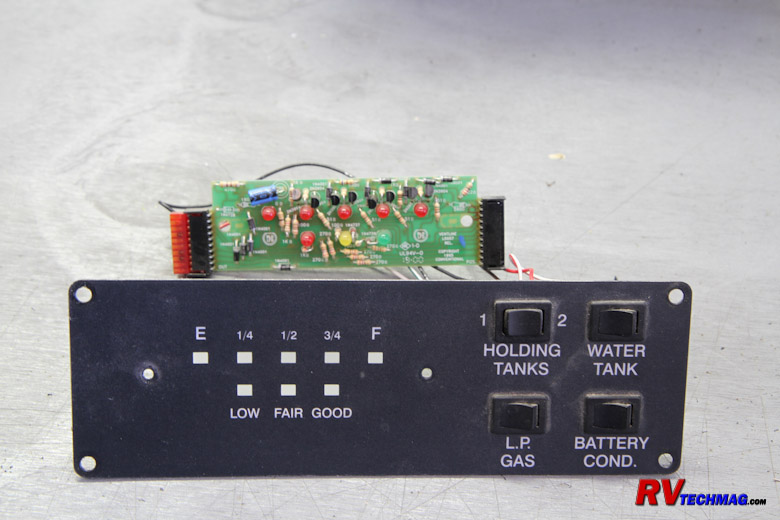
The Bounders original dash mounted display was quite wide and featured illuminated LEDs that reported in
1/4-tank increments.
|
The SeeLevel sensor strips are adaptable to any tank configuration. The strips are 12 inches long, but can be cut
to length for tanks that are shorter in height. If your tank is greater than 12 inches in height, two sensor strips can be configured
together to handle tanks up to 24 inches. Each strip has a number of tabs at the top that identify whether this is a fresh, gray, or black
tank. You simply snip off the tab to give that sensor a unique identity for that tank. All three sensors are then tied together and a single
wire connects them to the display panel. Each sensor can be run to ground or the ground LEDs may be tied together and run to the display
panel and grounded at a common location.
Prior to installing the sensors, hold the sensor strip against the tank to verify where you need to cut the strip
should it be too long for that tank. The strips are cut at 1-inch increments so your strip may be slightly shorter than the tank. In that
case positioning the gray and black strips near the top of the tank and the fresh water strip near the bottom will give you the most
useful readings.
The sensor strips come with a self-adhesive backing. To prepare the surface of the tank, wipe the area where the
sensor strip will be applied with acetone or alcohol to remove any oils or contamination. After it dries carefully peel of the backing
and apply the strip to the tank. Be careful not to bend the strips excessively or you might crack or damage the printed circuits on the strip.
Once the strips are firmly in place connect all of the blue wires from each sensor together and connect them to the blue wire on the display
panel. You can use one of the abandoned wires from the original internal sensors for this. The black wires need to go to ground. If you are
unable to find a good ground you can connect all of the black wires together and use a second abandoned wire from the original sensors to
connect to the display panel. You can then ground the entire system with one wire at the dash location.
The SeeLevel display panel was then connected to a battery hot power supply and ground. The original LP tank sensor
wire was relocated to the new display and our tank sensors were connected to complete the wiring. SeeLevel displays include diagnostic
software to verify sensor signal strengths and the LP tank sensor can also calibrated if required. In our case everything worked just fine
so we buttoned up the dash and the Bounder was good to go.
|
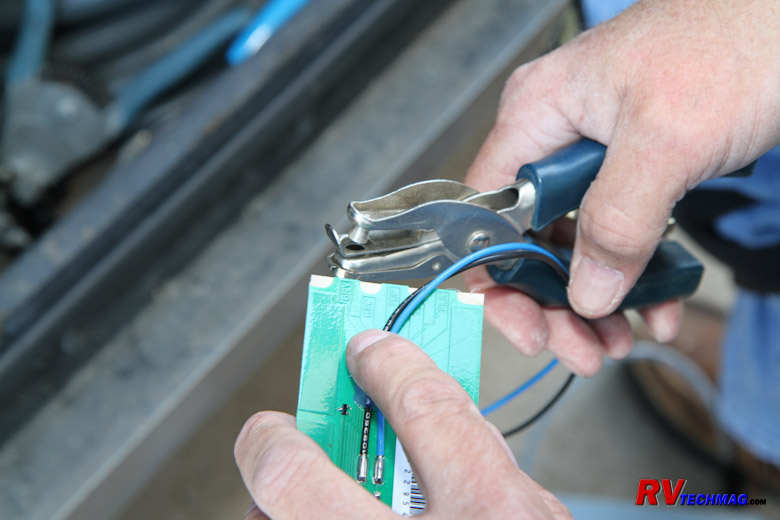
Each sensor strip comes with tabs that need to be trimmed to identify which tank each sensor strip is attached to.
Here a paper punch is used to give this sensor strip a unique identity.
|

Prior to attaching the sensor strips, the tank is wiped down with acetone or alcohol to ensure a good bond with the
self-adhesive sensor strip.
|
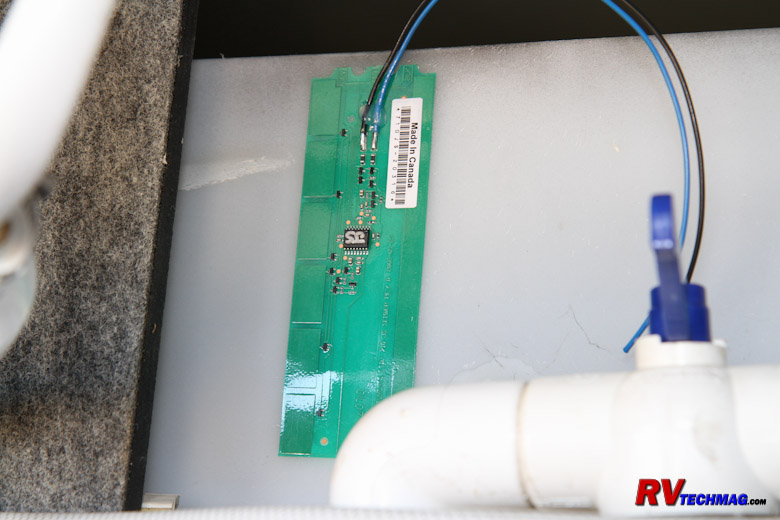
Once the sensor strip is attached all that remains is to connect the black wires to a good ground and the blue wires
to the display panel.
|
|
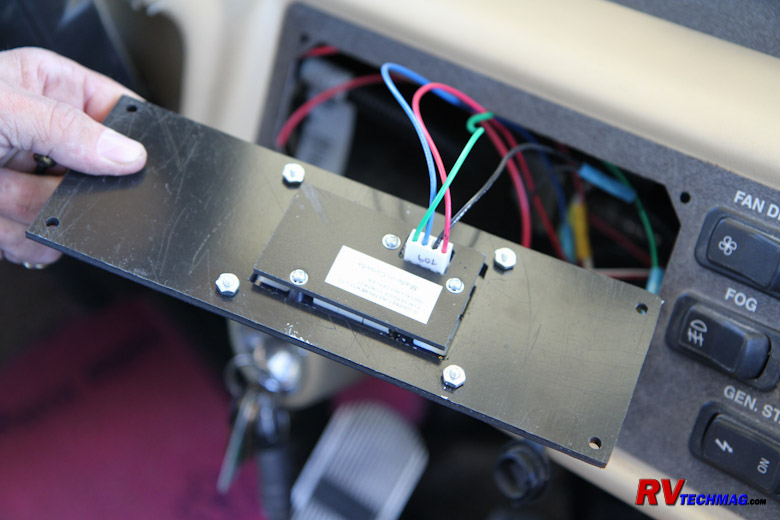
The modular pigtail on the back of the display only requires four wires - 12-volt hot, ground, LP tank, and holding
tank sensors.
|
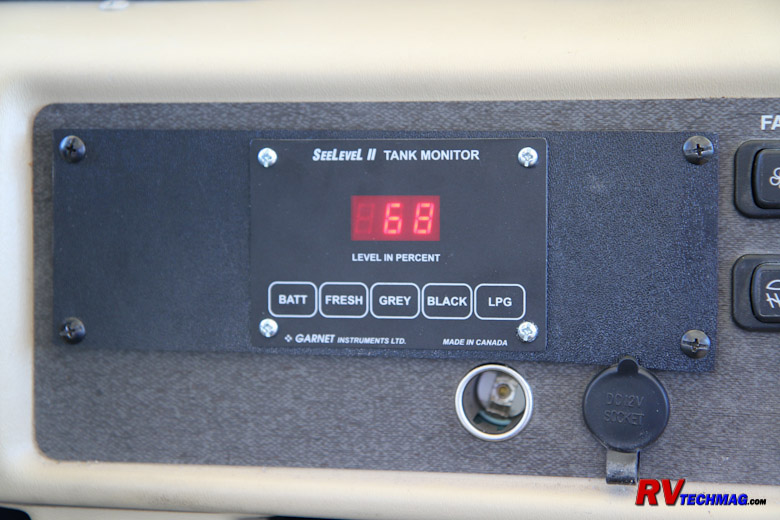
To accommodate the more compact SeeLevel display, a plastic filler panel was constructed to fill the hole in the dash
left by the removal of the oversized original display.
|
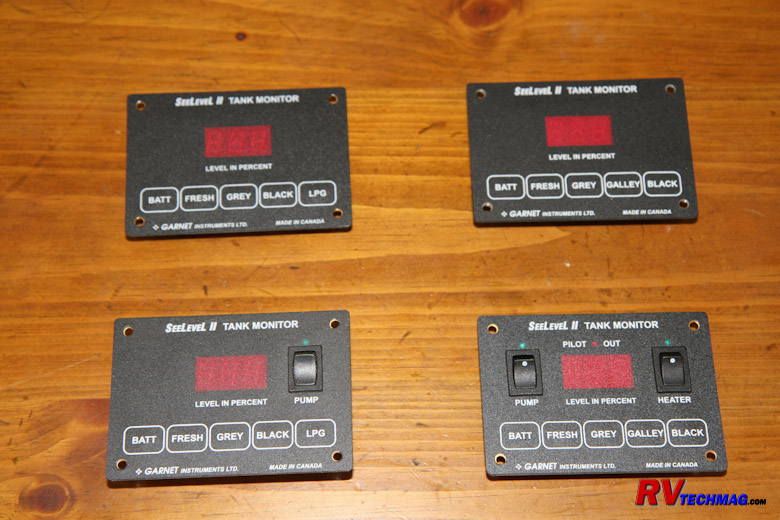
Many models of display panels are available, including three-tank and four-tank models. Models are also available with
water pump and water-heater switches.
|
SeeLevel Features
SeeLevel monitoring systems are available in a wide variety of configurations. The popular 709 series is
available with panels that have water pump and water heater switches or can handle multiple gray water tanks. A new addition to
the line includes the 709-A panel, which also includes analog outputs that can be used to trigger alarms or control macerator pumps.
Panels also are available with RVC network communications to interface with an Aladdin or Silverleaf system. LP tanks utilize the
existing in-tank sensor so no additional sensors are required. All you need to do is tap into the existing wire.
Multiple panels can be installed on a single RV. You may want to install a second display panel in the basement
water service bay to augment the display inside the coach. That way you will have current tank level information available while
dumping your holding tanks or filling your fresh water tank. I found this to be particularly useful when filling the fresh water
tank to know when you are getting close to being full. A second use I've found is when you want to partially drain a nearly full
gray tank to make room for showers but retain a portion for use in flushing the sewer hose after dumping the black tank later on.
The display can be locked on to monitor the gray tank and will display real-time tank level data so that you can stop the draining
cycle whenever you wish.
The sensors themselves are trouble free. No more fouling issues. They transmit their signal from one edge of
the sensor through the tank and receive the exact tank level on the other edge by measuring the refraction within the tank's contents.
The information is very accurate and displayed on an easy-to-read LED panel. An easy DIY installation makes this an attractive upgrade
for any RV owner who wants trouble free accurate information, this upgrade easily makes our "A" list. SeeLevel systems can be purchased
from a quality RV repair shop, online merchants such as RV Upgrades, or direct from Garnet Industries. A listing of dealers can be
found on the SeeLevel website for those who would rather have someone else do the installation.
Source
Garnet Technologies - SeeLevel
(877) 668-7813
www.rvguage.com
RV Upgrades
(866) 332-7881
www.rvupgradestore.com
Return to Home Page
If you enjoyed this article be sure to recommend RVtechMag.com to your friends, like us on Facebook or Twitter
or subscribe to our RSS feed.



|















